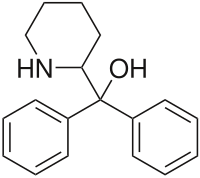This article needs additional citations for verification. (October 2015) |
 | |
| Clinical data | |
|---|---|
| ATC code | |
| Legal status | |
| Legal status |
|
| Identifiers | |
| |
| CAS Number | |
| PubChem CID | |
| ChemSpider | |
| UNII | |
| CompTox Dashboard (EPA) | |
| ECHA InfoCard | 100.006.723 |
| Chemical and physical data | |
| Formula | C18H21NO |
| Molar mass | 267.372 g·mol−1 |
| 3D model (JSmol) | |
| |
| |
| | |
Pipradrol, also known by its brand name Meratran, is a mild central nervous system stimulant that acts as a norepinephrine-dopamine reuptake inhibitor.[2] Developed in the United States in the 1940s and patented in 1953,[3] pipradrol was initially marketed as an antidepressant in the mid-1950s.[2] It was subsequently used as an adjunct treatment for various conditions, including obesity, senile dementia, narcolepsy, and schizophrenia.[2][4]
Despite its initial promise and relatively mild stimulant effects compared to stronger alternatives, concerns about its abuse potential led to its regulation and withdrawal from widespread use in many countries during the late 1970s.[2] Pipradrol is now classified as a controlled substance in several nations, including the United Kingdom, where it is typically placed in less restrictive drug schedules due to its lower abuse potential compared to other stimulants.[5]
- ^ Anvisa (2023-03-31). "RDC Nº 784 - Listas de Substâncias Entorpecentes, Psicotrópicas, Precursoras e Outras sob Controle Especial" [Collegiate Board Resolution No. 784 - Lists of Narcotic, Psychotropic, Precursor, and Other Substances under Special Control] (in Brazilian Portuguese). Diário Oficial da União (published 2023-04-04). Archived from the original on 2023-08-03. Retrieved 2023-08-16.
- ^ a b c d "Pipradrol". go.drugbank.com. Retrieved 2024-10-17.
- ^ Cite error: The named reference
Tilfordwas invoked but never defined (see the help page). - ^ Sargant W, Wayne EJ (May 1958). "Discussion on sedation and stimulation of man". Proceedings of the Royal Society of Medicine. 51 (5): 353–8. doi:10.1177/003591575805100512. PMC 1889636. PMID 13567677.
- ^ Wood DM, Dargan PI (September 2012). "Use and acute toxicity associated with the novel psychoactive substances diphenylprolinol (D2PM) and desoxypipradrol (2-DPMP)". Clinical Toxicology. 50 (8): 727–32. doi:10.3109/15563650.2012.716158. PMID 22882169.